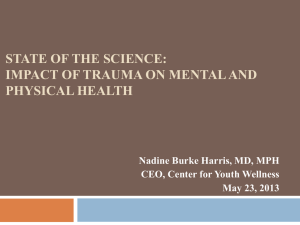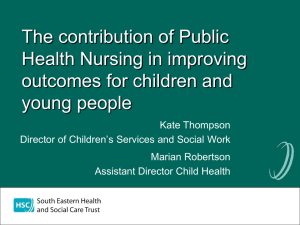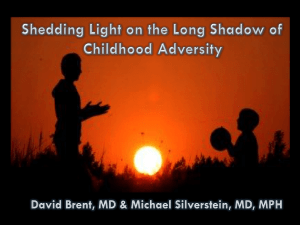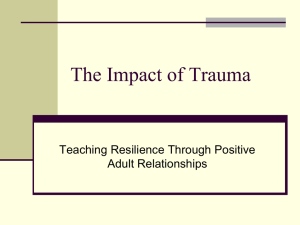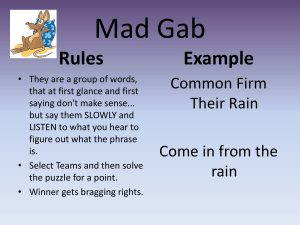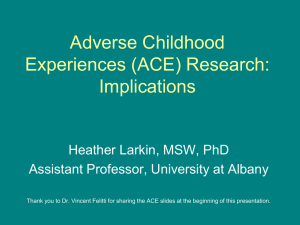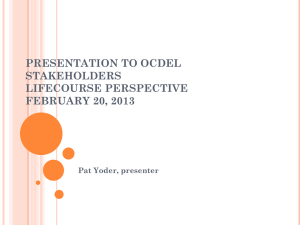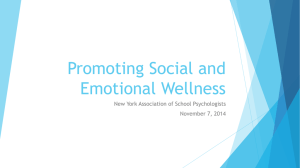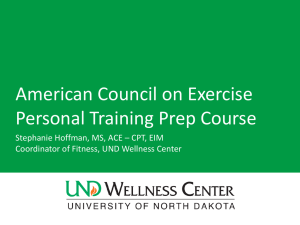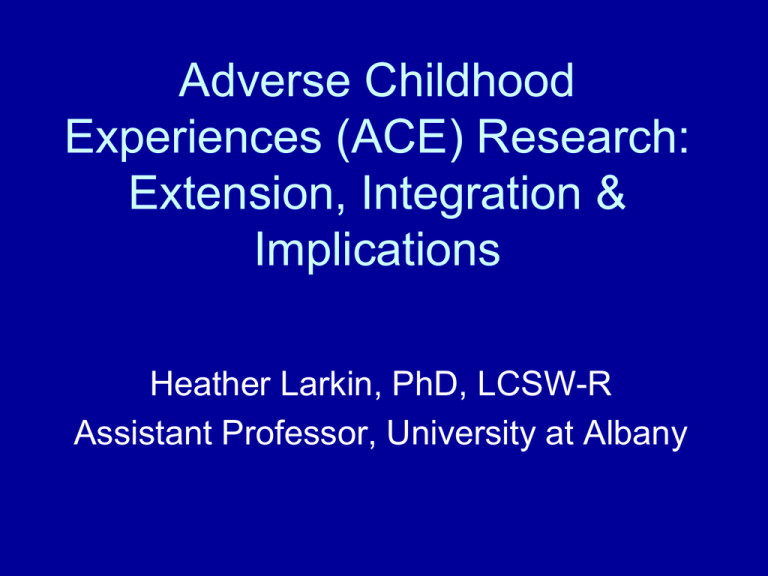
Adverse Childhood
Experiences (ACE) Research:
Extension, Integration &
Implications
Heather Larkin, PhD, LCSW-R
Assistant Professor, University at Albany
The Adverse Childhood Experiences Study
The largest study of its kind ever done to examine the
health and social effects of adverse childhood
experiences over the lifespan (Felitti & Anda)
• Experiences while
growing up that deeply
impact a young person
and profoundly affect
emotional and physical
health later in life.
(Thank you to Vincent Felitti for slides)
Categories of Adverse Childhood Experiences
Abuse, by Category
Category
Prevalence (%)
• Psychological (by parents)
11%
• Physical (by parents)
11%
• Sexual (anyone)
22%
Household Dysfunction, by Category
• Substance Abuse in family
26%
• Mental Illness in family
19%
• Domestic Violence
13%
• Imprisoned Household Member
3%
• Loss of parent
23%
Adverse Childhood Experiences Score
Number of categories of childhood experiences are
summed
ACE Score
Prevalence (after Wave 2)
0
33%
1
25%
2
15%
3
10%
4
6%
5 or more
11%
• Approximately two-thirds have at least one ACE
• More than one-third have experienced
2 – 4 ACE categories
The Adverse Childhood Experiences
(ACE) Study
Summary of Findings:
• Adverse Childhood Experiences (ACEs)
are very common
• ACEs are strong predictors of adult
health risks and disease
• ACEs are implicated in the 10 leading causes of death in the
U.S.!
•
“I was actually stunned and I wept over what I saw.” ACEs
researcher Rob Anda, M.D.
•
Virtually every study shows that ACEs are strong predictors of
homelessness (Burt, 2001)
Adverse Childhood Experiences
and Current Smoking
20
18
16
14
12
%
10
8
6
4
2
0
0
1
2
3
ACE Score
4-5
6 or more
Childhood Experiences and
Adult Alcoholism
18
16
4+
% Alcoholic
14
12
3
10
2
8
6
1
4
2
0
0
ACE Score
% With a Lifetime History of
Depression
Childhood Experiences
Underlie Chronic Depression
80
70
60
50
40
30
20
Women
Men
10
0
0
1
2
ACE Score
3
>=4
Childhood Experiences
Underlie Suicide
25
4+
% Attempting Suicide
20
15
3
10
2
5
0
1
0
ACE Score
Ever Hallucinated* (%)
ACE Score and Hallucinations
Abused
Alcohol
or Drugs
12
10
8
No
Yes
6
4
2
0
0
1
2
3
4
5
6
ACE Score
*Adjusted for age, sex, race, and education.
>=7
ACE Score and Intravenous Drug Use
% Have Injected Drugs
3.5
3
2.5
2
1.5
1
0.5
0
0
1
2
3
4 or more
ACE Score
N = 8,022
p<0.001
% with Job Problems
ACE Score and
Serious Job Problems
18
16
14
12
10
8
6
4
2
0
0
1
2
ACE Score
3
4 or more
A Connection with Homelessness
• Mental illness and substance abuse
problems are more common among
homeless people
• ACEs connection to substance abuse and
mental illness
• Even non-homeless people with either
substance abuse problems or mental illness
are less likely to hold a job
University at Albany School of
Social Welfare: ACE Response
• Enhance our understanding of ACEs
• Integrate with literature on resiliency and
protective factors
• Prevention and Intervention for each ACE
outcome
• Support systems transformation
Person-in-Environment: A complex
interplay of risk and resources
ACE impact on
developing self
(overwhelming feelings,
activation of defense
mechanisms, etc.)
Health Risk Behaviors
(substance abuse, sexual
and other risk-taking, etc.)
Medical problems (both
short & long-term)
Changes in developing brain
INDIVIDUAL
COLLECTIVE
Family meanings
Family relational system/ACEs
Cultural values
Social violence
Social taboos
Health, Mental health, & Substance abuse
services
Victim blaming
Social service , school, & criminal justice
systems
“rugged individualism”
Public health policy responses
Development, behavior, health, culture, and
systems
• Developmental theorists (Piaget, Kohlberg, Gilligan,
Loevinger, Freud, and others)
• Impact of ACEs and health risk behaviors on
development
• The role of culture and social systems
• Service interventions that prevent or effectively treat
ACEs sooner might prevent homelessness (& other
serious health and social outcomes) later in life
Key Milestones
• Felitti and Anda visits – 2007, 2008, 2009
• Policy Lunch – May 2009
• Council on Children and Families – June 2009,
September 2009
• ACE Think Tank and Action Teams
– Rob Anda, Vincent Felitti, Fred Bolton
• ACE Steering Committee
• NYS Omnibus Survey
• Multi-state ACE Learning Community
• ACE Response website – January 2011
(www.aceresponse.org)
Implications
• ACE Response: Fostering resilience &
mobilizing protective factors
• Workforce development
• Practice, programs, policies that take
trauma into account
• Cross-system linkages/ service integration
(TRANSFORMATION)

